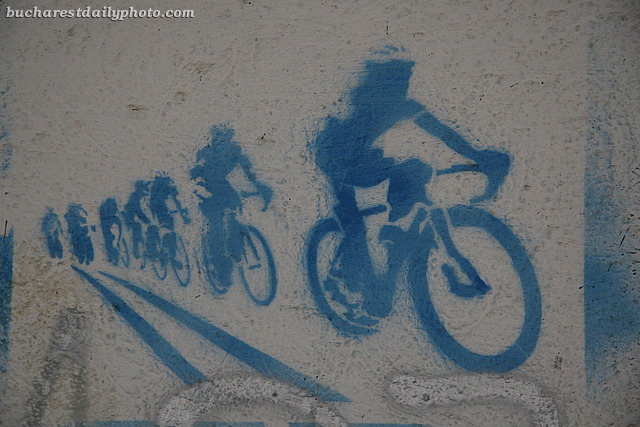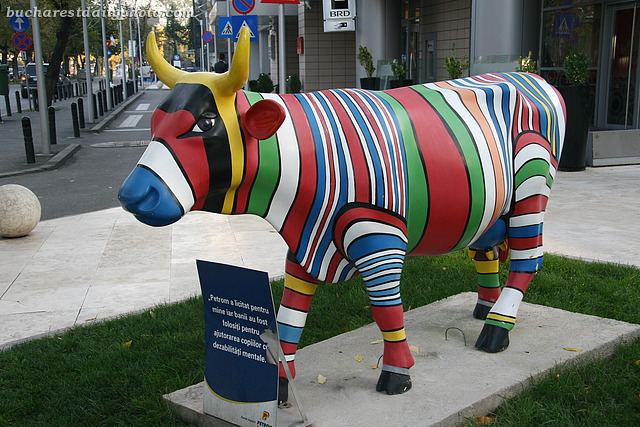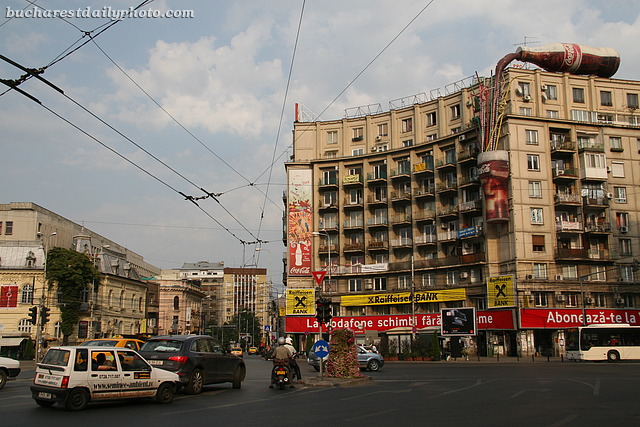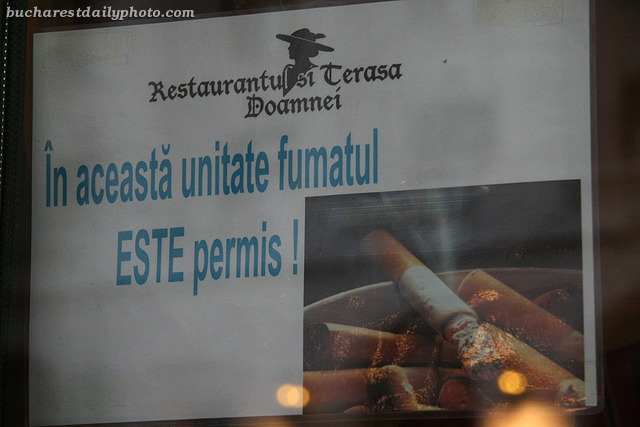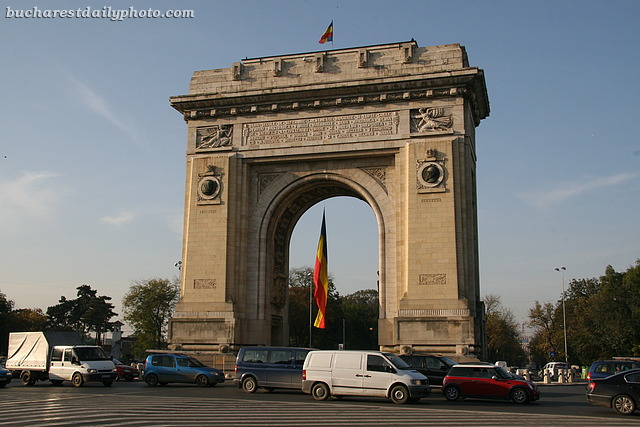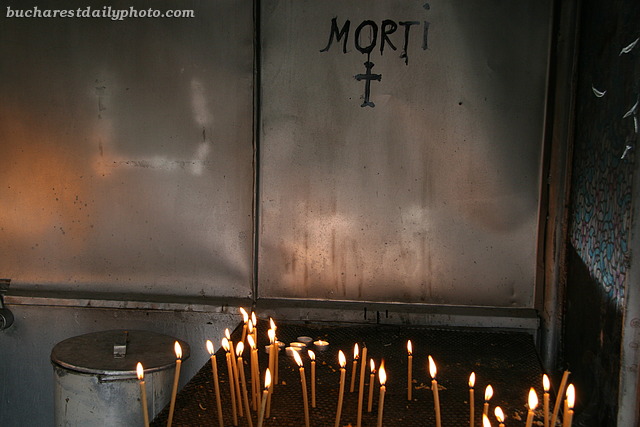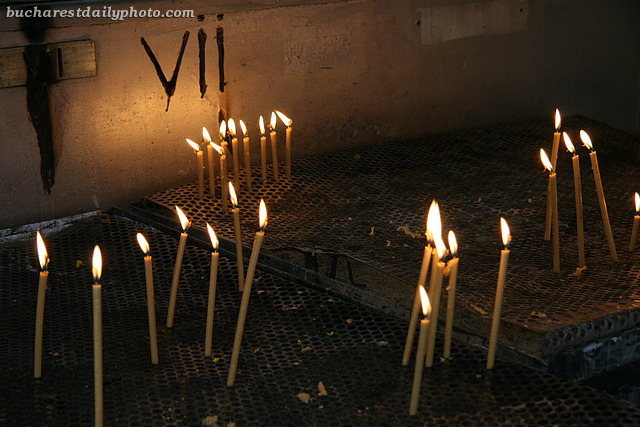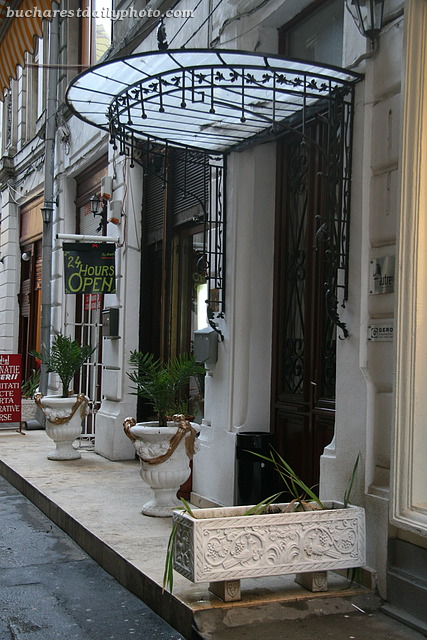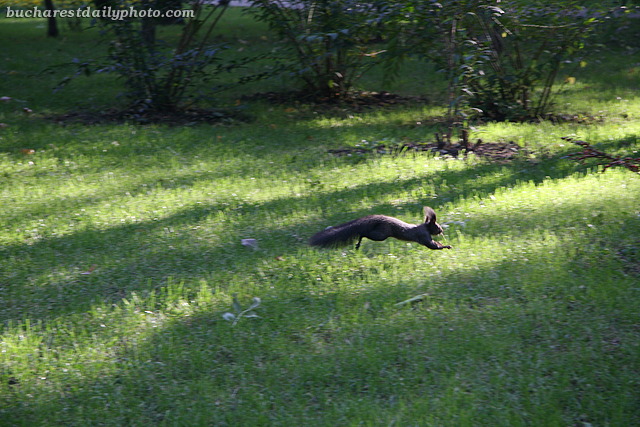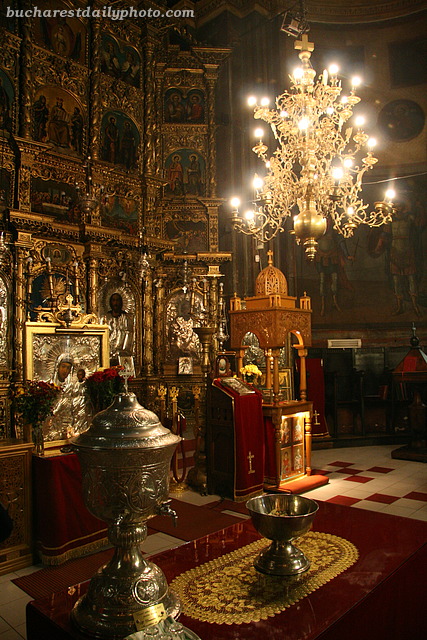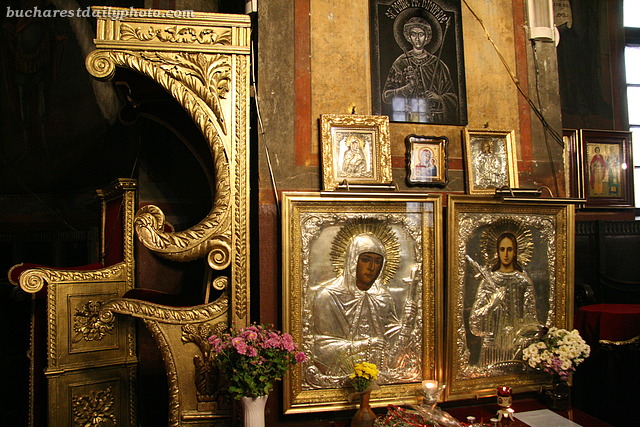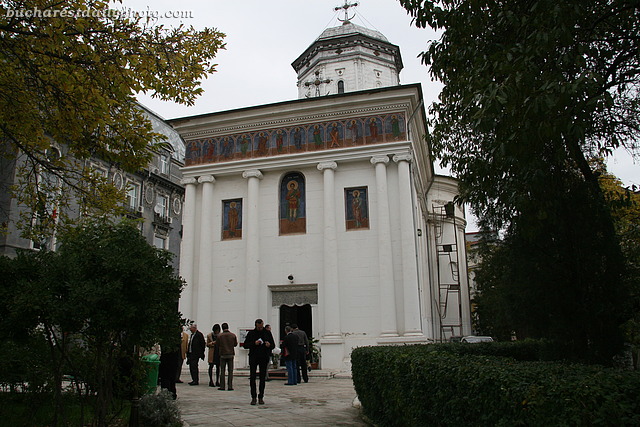I haven’t posted a stencil graffiti in a long while and thought it was time to remedy that. The one in today’s photograph seems to tell the citizens of Bucharest to get moving. And I agree with it, Bucharest definitely needs more of these – bicyclists not graffiti.
Are you familiar with the CowParade? You probably are if you live or visited (at the right moment) one of the over 50 cities in which it was staged. According to their web page, it has been one of the most successful public art events in the world. I personally caught them in New York City in 2000 and Florence in 2005. Bucharest was the site of the CowParade in the summer of 2005, when local and international artists painted the fiberglass cows that were displayed all over the city. After the closing of the event the cows were sold in an auction and the money went to charity. Some of cows that were auctioned were redisplayed for the public to see, like the one in today’s photo which I photographed on Calea Dorobanţi.
For today, a photograph from the Roman Square, (Piaţa Romană in Romanian) which I mentioned in the She Wolf post last week. The Roman Square is a major traffic intersection in downtown Bucharest. Set around 1900, the square has a circular shape and a big roundabout. Three major boulevards intersect here. What you see in the picture is the southeast corner. The square is served by a subway station and is a major transport hub for buses and taxis. The huge Coca Cola bottle pouring into a glass stuck to the side of the building has been there for more than two years (if I remember correctly). I took the picture at the beginning of September. It will be some time before we see a sky so blue again.
Bucharest is by all means a smoker’s paradise. According to some numbers I found on the web, in Romania some 45% of men and 25% of women smoke, but I wonder if the numbers are correct because it feels like the percentage is a lot higher, especially among women. Smoking is still seen as harmless and fashionable, people still think cigarettes are cool and a way to express oneself. I’ve seen many parents smoking right into the noses of their children, I’ve seen pregnant women smoke and I’ve seen doctors smoking on the hospital’s hallways. Some tourists find it really annoying, some find it liberating. Smoking is not allowed in most public places but … if the law is respected that’s another story. Since January 1st the new law regarding smoking in restaurants and cafes demands that smoking is only allowed in areas completely separated from the non-smoking section, the smoking area should not form more than 50% of the total area of the restaurant or bar, and should not be areas used for transit nor near the entrance. Restaurants and bars which have a total surface of less than 100 square meters can designate themselves as smoking or non-smoking venues and that should be clearly posted on the door. What was the result of this verbose law? Almost all restaurants in Bucharest declared themselves as “smoking establishments” just like the one in today’s photo. Posted on the door the message reads “Smoking IS permitted inside this venue”.
Bucharest’s Triumphal Arch (Arcul de Triumf in Romanian) lies in a very busy intersection in northern Bucharest. Designed by the architect Petre Antonescu, the structure was erected in 1935-1936 to commemorate the creation of Greater Romania which took place in 1918. This arch is the third triumphal arch built in Bucharest. The first arch made of wood and cardboard was erected in a rush in 1878 to mark Romania’s independence from the Turks. Victorious troops marched under it on their arrival in Bucharest. This first arch was replaced by a second one, located on the same spot as the current arch and also designed by Petre Antonescu. It was erected in 1922 to mark Ferdinand’s entry into Bucharest as the first king of Greater Romania. In 1935 the arch was in pretty bad shape so it was thoroughly renovated and became the structure that we see today, built of concrete and granite. Portraits of King Ferdinand and Queen Marie decorate one face, while the names of battles fought by Romanians during the First World War can be seen on the other face. The portraits of the king and queen were removed during the communist rule but they were readded in 1992. The sculptures decorating the arch were created by leading artists of the day, including Ion Jalea, D. Onofrei and Constantin Baraschi. Sometimes, on special occasions, the arch is open for visitation.
In the last few years Bucharest’s Triumphal Arch became the site of a strange wedding ritual which I won’t tell you about right now, on the hope that one of these days I’ll make a photo that would better tell the story. If you’re really curious and want a sneak peak just follow these youtube links: one and two.
Today’s two photos are part of the St. Dumitru Chuch series. In the Eastern Orthodox church, candles are used in religious ceremonies or are lit by worshippers as offerings. In Bucharest churches the candle cabinets are usually placed outside the church, to protect it from fire and damage by smoke. The cabinets can be small or large, usually with doors to protect the candles from rain or from blowing out when it’s windy outside. As you can see in the photos, the cabinets are marked with “Dead” (“Morţi” in Romanian) or “Alive” (“Vii” in Romanian) as you can either light a remembrance candle for somebody who died or one to pray for help for the soul of someone who’s alive and going through harsh times.
Today is Theme Day at the City Daily Photo community, a monthly event that happens the first day of every month, when all participating blogs will post a picture that relates to the theme day’s description. Today’s theme is Doorways. Click here to view thumbnails for all participants
This style of doorways, covered with glass awnings in wrought iron frames became very popular in Bucharest at the end of the 19th century. You can still find many houses in the historic quarters of Bucharest that have these French inspired style doors with awnings. The most flamboyant glass awning in Bucharest is the one at the Cantacuzino Palace which I already introduced in a post in September.
Something fun, fit for a Saturday …
I don’t know why but it’s rare to see squirrels in Bucharest’s parks. So I was surprised when I was able to spot one in Kiseleff park last week. The photograph is a bit unclear because the squirrel was moving continuously and the lighting conditions were not the best.
I don’t like to take pictures inside churches because there’s always someone praying and I feel like intruding. But being at the church with the occasion of a baptizing I waited until everyone left and snapped a few quick shots. I don’t know if you had the occasion of visiting a Eastern Orthodox Church before, but what you see in today’s photographs is a pretty typical interior. Icons are not considered to be idols or objects of worship by the Eastern Orthodox, the thinking being that an icon is like a window and that is not the physical object that is venerated but rather the individual shown. Therefore orthodox churches have many icons adorning the walls, in fact many of them are completely covered in icons or frescoes. Also, as you can see in the second photograph, icons are often illuminated by a candle or oil lamp.
Last Sunday I was invited to a baptizing at this charming church that goes by the name of Saint Dumitru Church, also called “of Oath Taking” because in the 17th century the parts involved in a trial would come here and take an oath to tell the truth while wearing the Holy Belt of the Virgin Mary. It is also called “Saint Dumitru at the Post Office”, because of its location, and in the past it used to be called “Saint Dumitru of Badea Bălăceanu”, after the name of one of the first patrons of the church. Although it is located in Bucharest’s Old Town, this church is far less popular than its close neighbour Stavropoleous Church.
This peaceful looking church has quite a stormy history. You can skip this part if you’re not interested. I won’t tell 🙂 There was a wooden church on these grounds as early as the 15th century but it was destroyed in 1595. Rebuilt in the beginning of the 17th century, it was left to ruin after its patron Bălăceanu fell from grace with the Prince of Wallachia Constantin Brăncoveanu. Rebuilt again between the years 1741-1746 and again left to ruin at the end of the 18th century. The church is then damaged in the earthquake of 1802 and what was left of it is burned in a fire in 1804. Then the cycle restarts. Rebuilt in 1843, the building burns down in Great Fire of 1847. The current building dates from 1852 but since then it was again damaged by earthquake and reinforced and renovated many times. After the First World War the church has been abandoned and proposed for demolition but thanks to a media campaign funds were obtained to renovated it. I think it looks pretty nice now.
